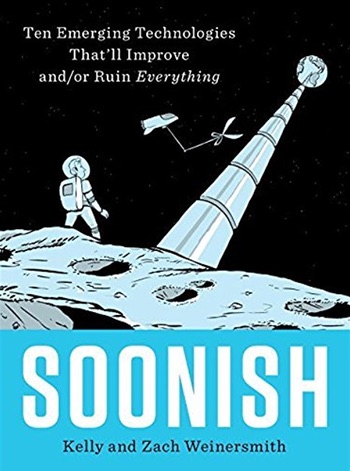Review: Soonishby Jeff Foust
|
| The book’s “Graveyard of Lost Chapters” includes space-based solar power, which they conclude is “undesirable even under its most ideal conditions.” |
Sure enough, space elevators are included in the book, as part of a chapter on cheap access to space—treated as a singular technology, when it is, in fact, a grab-bag of disparate concepts with a common goal. That chapter also includes other approaches, from reusable rockets to giant guns. (There’s, oddly, very little discussion of SpaceX’s achievements with reusability, or similar efforts by other companies like Blue Origin, even though it’s showing promise today, compared to alternatives in the chapter.) Another chapter takes on asteroid mining, looking at the technology and economics of extracting resources from such bodies. The rest of the book is focused on non-space technologies, from fusion power and robotic construction to synthetic biology and brain-computer interfaces.
Each chapter takes on a technology with a mixture of seriousness and irreverence. They talk with experts and examine both the current state of the technology and its ramifications, positive and negative, should it become commonplace. They also have some fun with the subject matter, though, both in the text and with the frequent cartoons. That can be an interesting way to liven up dry, technical subject matter, but at times it can seem a little juvenile, like when they play up the name of one scientist discussing asteroid mining, Harvard professor Martin Elvis. Yes, they had a lot of fun with that.
The end of the book includes a “Graveyard of Lost Chapters,” a discussion of technologies that didn’t make it into the book for one reason or another. That includes space-based solar power, which they conclude is “undesirable even under its most ideal conditions,” primarily because it’s not as economical as terrestrial solar power—a view shared by many skeptics of space-based solar power. That’s understandable, yet they had no qualms about including concepts like space elevators in the book that require technologies that don’t exist today, such as materials strong enough to support a cable 100,000 kilometers required for a space elevator. (Carbon nanotubes have shown promise of solving that for about 15 years, but so far they’ve shown only promise.) By contrast, space-based solar power’s obstacles are less technological and more economic.
Space enthusiasts probably won’t learn much from the space-related chapters in Soonish other than to see—and potentially dispute—what technologies are included and the authors’ assessment of them. It is enlightening, though, for the other concepts included in the book, both in the capabilities of the technologies themselves and how they stack up with space in the ability to change our civilization.
